本文介绍在3D目标检测中,理解和使用KITTI 数据集,包括KITTI 的基本情况、下载数据集、标签格式解析、3D框可视化、点云转图像、画BEV鸟瞰图等,并配有实现代码。
目录
1、KITTI数据集3D框可视化
2、KITTI 3D数据集
3、下载数据集
4、标签格式
5、标定参数解析
6、点云数据-->投影到图像
7、图像数据-->投影到点云
8、可视化图像2D结果、3D结果
9、点云3D结果-->图像BEV鸟瞰图结果(坐标系转换)
10、绘制BEV鸟瞰图
11、BEV鸟瞰图画2d框
12、完整工程代码
1、KITTI数据集3D框可视化
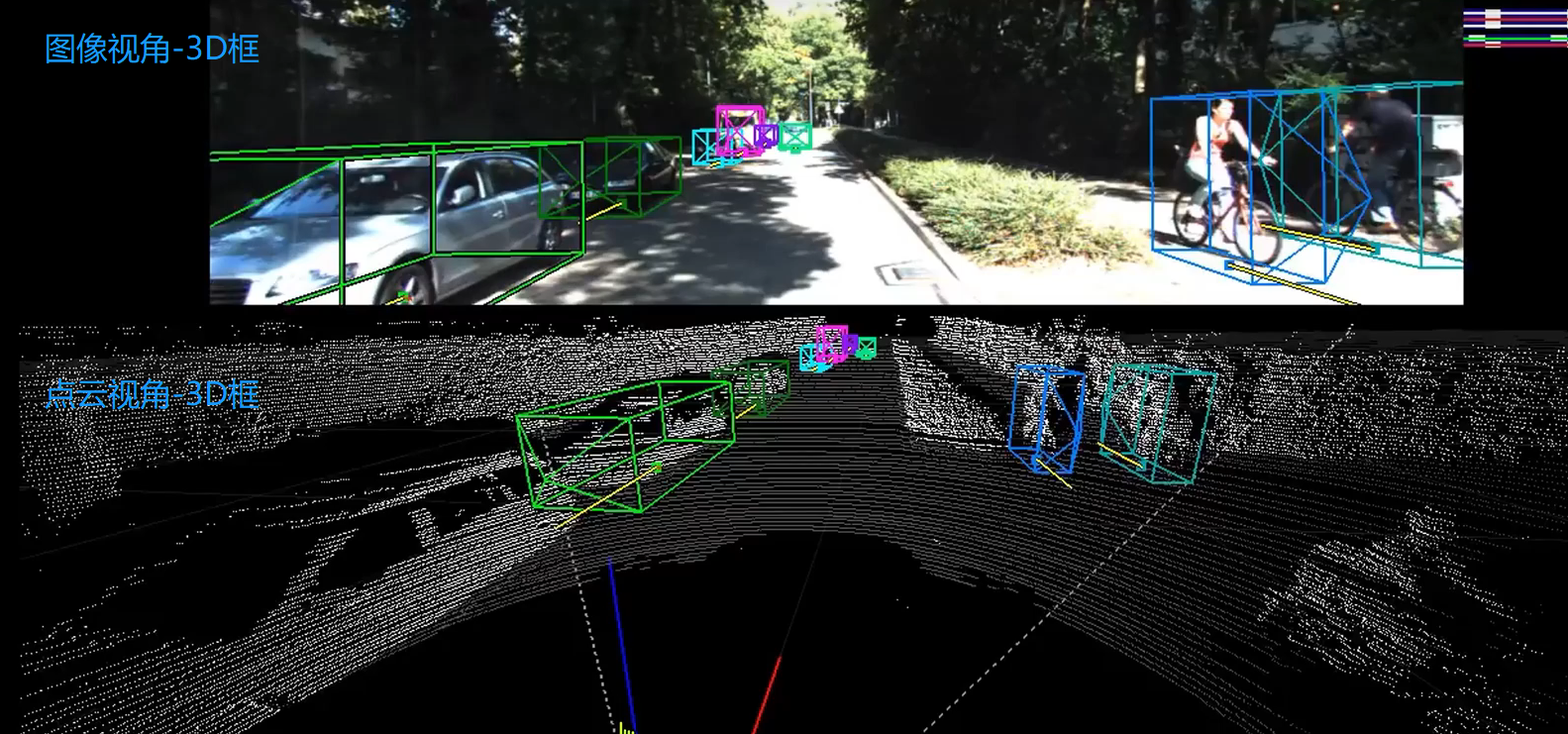
2、KITTI 3D数据集
kitti 3D数据集的基本情况:
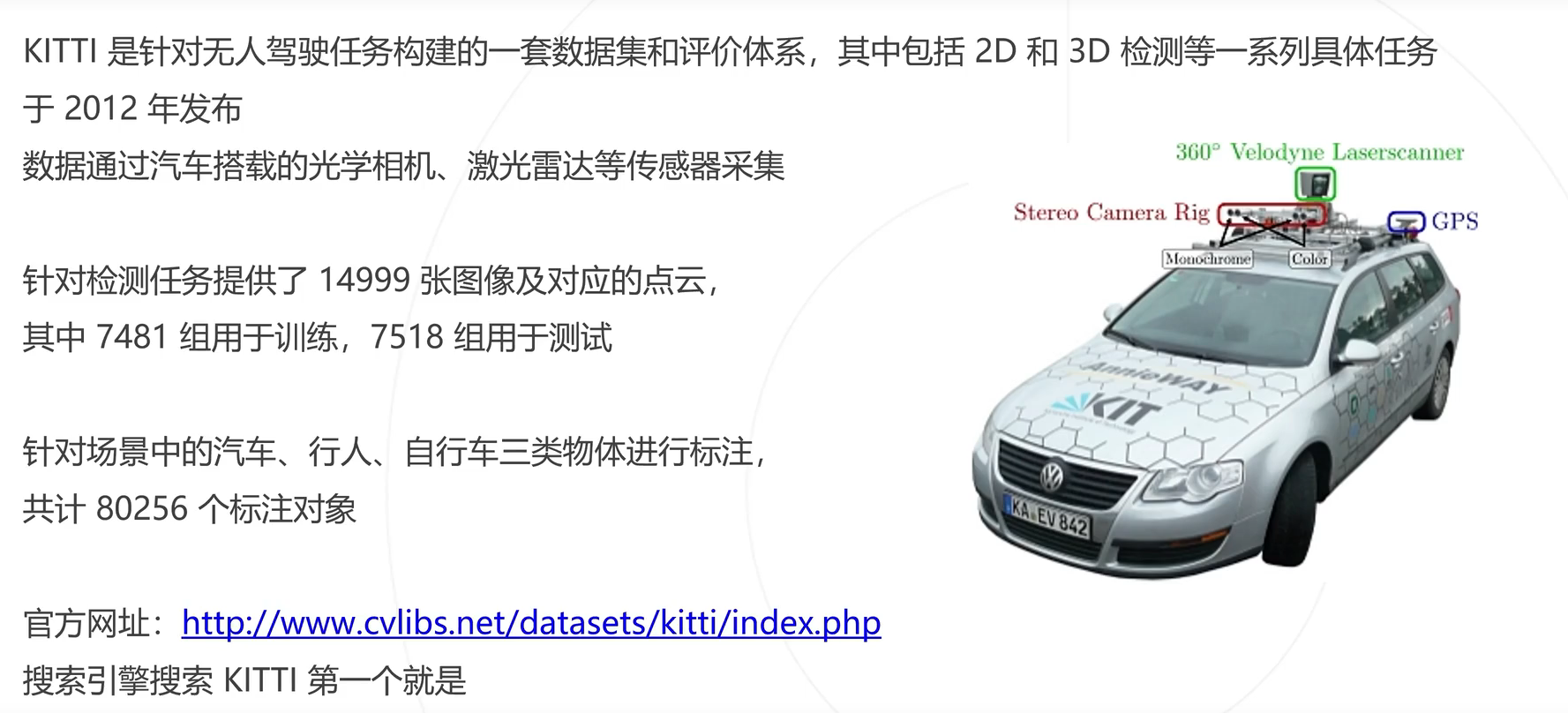
KITTI整个数据集是在德国卡尔斯鲁厄采集的,采集时长6小时。KITTI官网放出的数据大约占采集全部的25%,去除了测试集中相关的数据片段,按场景可以分为“道路”、“城市”、“住宅区”、“校园”和“行人”5类。
传感器配置:

传感器安装位置:
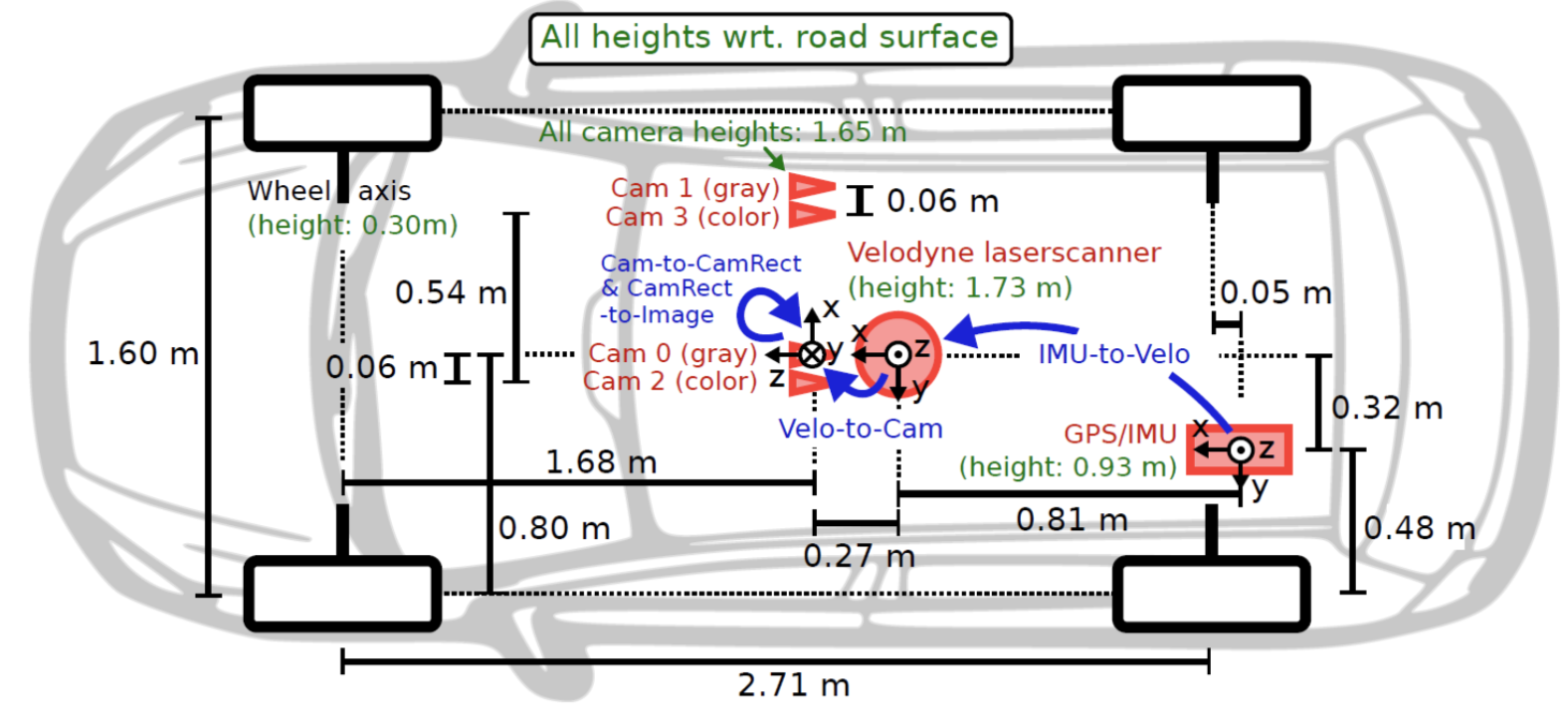
3、下载数据集
The KITTI Vision Benchmark Suite (cvlibs.net)
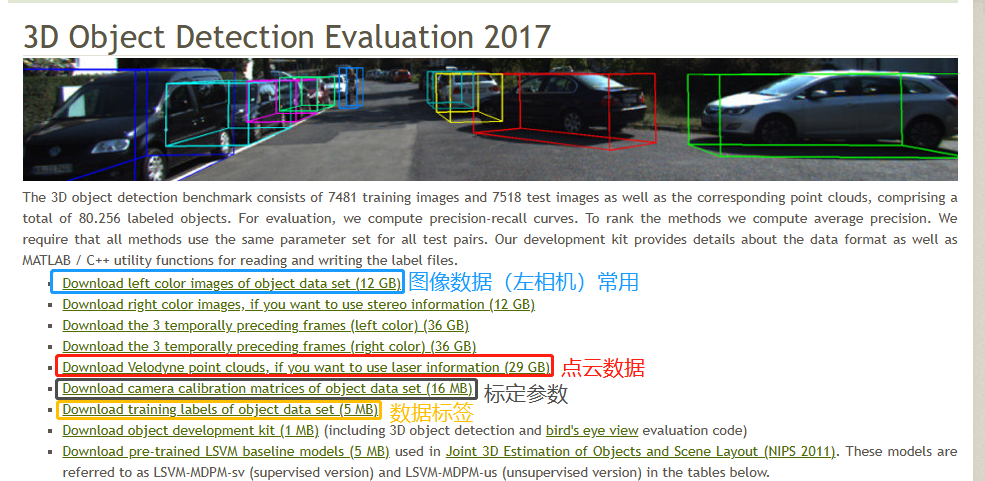
下载数据需要注册账号的,获取取百度网盘下载;文件的格式如下所示
图片格式:xxx.jpg
点云格式:xxx.bin(点云是以bin二进制的方式存储的)
标定参数:xxx.txt(一个文件中包括各个相机的内参、畸变校正矩阵、激光雷达坐标转到相机坐标的矩阵、IMU坐标转到激光雷达坐标的矩阵)
标签格式:xxx.txt(包含类别、截断情况、遮挡情况、观测角度、2D框左上角坐标、2D框右下角坐标、3D物体的尺寸-高宽长、3D物体的中心坐标-xyz、置信度)
4、标签格式
示例标签:Pedestrian 0.00 0 -0.20 712.40 143.00 810.73 307.92 1.89 0.48 1.20 1.84 1.47 8.41 0.01
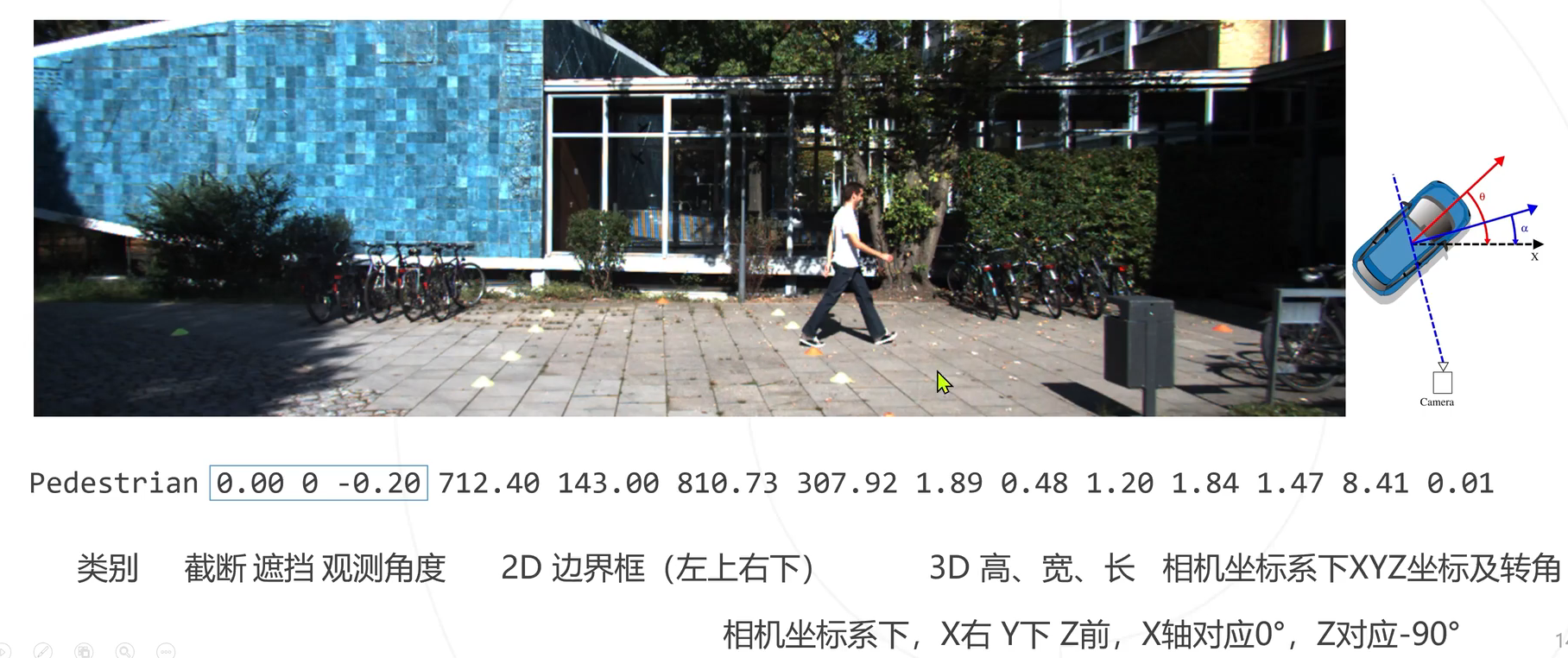
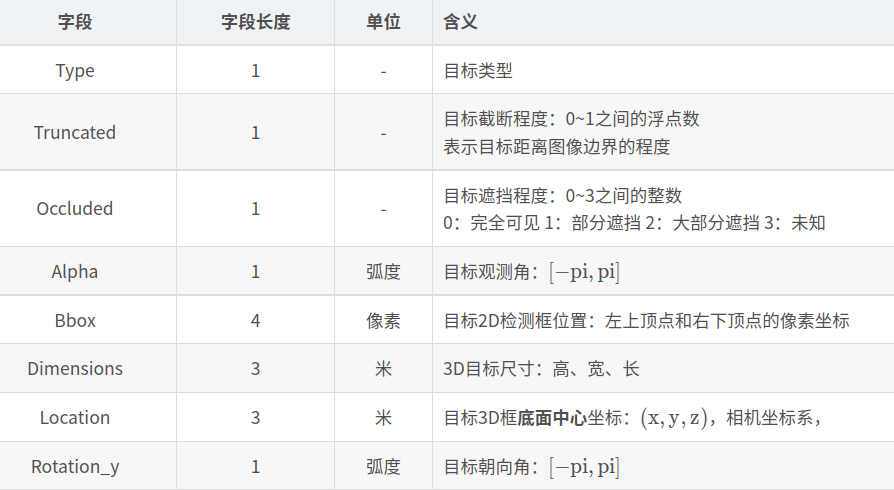
这时可以看看这个视频:
Nuscenes、KITTI等多个BEV开源数据集介绍
5、标定参数解析
然后看一下标定参数:
P0-P3:是各个相机的内参矩阵;3×4的相机投影矩阵,0~3分别对应左侧灰度相机、右侧灰度相机、左侧彩色相机、右侧彩色相机。
R0_rect: 是左相机的畸变矫正矩阵;3×3的旋转修正矩阵。
Tr_velo_to_cam:是激光雷达坐标系 转到 相机坐标系矩阵;3×4的激光坐标系到Cam 0坐标系的变换矩阵。
Tr_imu_to_velo: 是IMU坐标转到激光雷达坐标的矩阵;3×4的IMU坐标系到激光坐标系的变换矩阵。

6、点云数据-->投影到图像
当有了点云数据信息,如何投影到图像中呢?本质上是一个坐标系转换的问题,流程思路如下:
- 已知点云坐标(x,y,z),当前是处于激光雷达坐标系
- 激光雷达坐标系 转到 相机坐标系,需要用到标定参数中的Tr_velo_to_cam矩阵,此时得到相机坐标(x1,y1,z1)
- 相机坐标系进行畸变矫正,需要用到标定参数中的R0_rect矩阵,此时得到相机坐标(x2,y2,z2)
- 相机坐标系转为图像坐标系,需要用到标定参数中的P0矩阵,即相机内存矩阵,此时得到图像坐标(u,v)
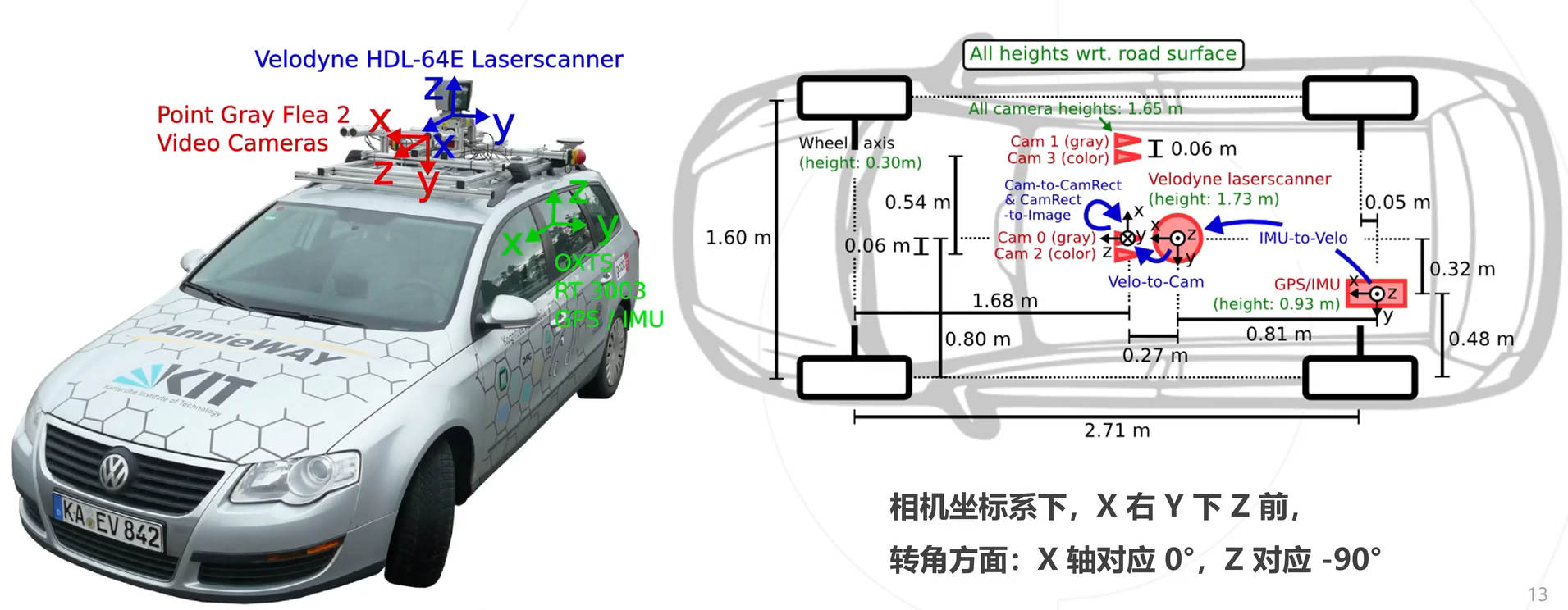
看一下示例效果:

接口代码:
'''
将点云数据投影到图像
'''
def show_lidar_on_image(pc_velo, img, calib, img_width, img_height):
''' Project LiDAR points to image '''
imgfov_pc_velo, pts_2d, fov_inds = get_lidar_in_image_fov(pc_velo,
calib, 0, 0, img_width, img_height, True)
imgfov_pts_2d = pts_2d[fov_inds,:]
imgfov_pc_rect = calib.project_velo_to_rect(imgfov_pc_velo)
import matplotlib.pyplot as plt
cmap = plt.cm.get_cmap('hsv', 256)
cmap = np.array([cmap(i) for i in range(256)])[:,:3]*255
for i in range(imgfov_pts_2d.shape[0]):
depth = imgfov_pc_rect[i,2]
color = cmap[int(640.0/depth),:]
cv2.circle(img, (int(np.round(imgfov_pts_2d[i,0])),
int(np.round(imgfov_pts_2d[i,1]))),
2, color=tuple(color), thickness=-1)
Image.fromarray(img).save('save_output/lidar_on_image.png')
Image.fromarray(img).show()
return img
核心代码:
'''
将点云数据投影到相机坐标系
'''
def get_lidar_in_image_fov(pc_velo, calib, xmin, ymin, xmax, ymax,
return_more=False, clip_distance=2.0):
''' Filter lidar points, keep those in image FOV '''
pts_2d = calib.project_velo_to_image(pc_velo)
fov_inds = (pts_2d[:,0]=xmin) & \
(pts_2d[:,1]=ymin)
fov_inds = fov_inds & (pc_velo[:,0]>clip_distance)
imgfov_pc_velo = pc_velo[fov_inds,:]
if return_more:
return imgfov_pc_velo, pts_2d, fov_inds
else:
return imgfov_pc_velo
7、图像数据-->投影到点云
当有了图像RGB信息,如何投影到点云中呢?本质上是一个坐标系转换的问题,和上面的是逆过程,流程思路如下:
- 已知图像坐标(u,v),当前是处于图像坐标系
- 图像坐标系 转 相机坐标系,需要用到标定参数中的P0逆矩阵,即相机内存矩阵,得到相机坐标(x,y,z)
- 相机坐标系进行畸变矫正,需要用到标定参数中的R0_rect逆矩阵,得到相机坐标(x1,y1,z1)
- 矫正后相机坐标系 转 激光雷达坐标系,需要用到标定参数中的Tr_velo_to_cam逆矩阵,此时得到激光雷达坐标(x2,y2,z2)
8、可视化图像2D结果、3D结果
先看一下2D框的效果:

3D框的效果:

接口代码:
'''
在图像中画2D框、3D框
'''
def show_image_with_boxes(img, objects, calib, show3d=True):
img1 = np.copy(img) # for 2d bbox
img2 = np.copy(img) # for 3d bbox
for obj in objects:
if obj.type=='DontCare':continue
cv2.rectangle(img1, (int(obj.xmin),int(obj.ymin)), (int(obj.xmax),int(obj.ymax)), (0,255,0), 2) # 画2D框
box3d_pts_2d, box3d_pts_3d = utils.compute_box_3d(obj, calib.P) # 获取图像3D框(8*2)、相机坐标系3D框(8*3)
img2 = utils.draw_projected_box3d(img2, box3d_pts_2d) # 在图像上画3D框
if show3d:
Image.fromarray(img2).save('save_output/image_with_3Dboxes.png')
Image.fromarray(img2).show()
else:
Image.fromarray(img1).save('save_output/image_with_2Dboxes.png')
Image.fromarray(img1).show()
核心代码:
def compute_box_3d(obj, P):
'''
计算对象的3D边界框在图像平面上的投影
输入: obj代表一个物体标签信息, P代表相机的投影矩阵-内参。
输出: 返回两个值, corners_3d表示3D边界框在 相机坐标系 的8个角点的坐标-3D坐标。
corners_2d表示3D边界框在 图像上 的8个角点的坐标-2D坐标。
'''
# 计算一个绕Y轴旋转的旋转矩阵R,用于将3D坐标从世界坐标系转换到相机坐标系。obj.ry是对象的偏航角
R = roty(obj.ry)
# 物体实际的长、宽、高
l = obj.l;
w = obj.w;
h = obj.h;
# 存储了3D边界框的8个角点相对于对象中心的坐标。这些坐标定义了3D边界框的形状。
x_corners = [l/2,l/2,-l/2,-l/2,l/2,l/2,-l/2,-l/2];
y_corners = [0,0,0,0,-h,-h,-h,-h];
z_corners = [w/2,-w/2,-w/2,w/2,w/2,-w/2,-w/2,w/2];
# 1、将3D边界框的角点坐标从对象坐标系转换到相机坐标系。它使用了旋转矩阵R
corners_3d = np.dot(R, np.vstack([x_corners,y_corners,z_corners]))
# 3D边界框的坐标进行平移
corners_3d[0,:] = corners_3d[0,:] + obj.t[0];
corners_3d[1,:] = corners_3d[1,:] + obj.t[1];
corners_3d[2,:] = corners_3d[2,:] + obj.t[2];
# 2、检查对象是否在相机前方,因为只有在相机前方的对象才会被绘制。
# 如果对象的Z坐标(深度)小于0.1,就意味着对象在相机后方,那么corners_2d将被设置为None,函数将返回None。
if np.any(corners_3d[2,:]<0.1):
corners_2d = None
return corners_2d, np.transpose(corners_3d)
# 3、将相机坐标系下的3D边界框的角点,投影到图像平面上,得到它们在图像上的2D坐标。
corners_2d = project_to_image(np.transpose(corners_3d), P);
return corners_2d, np.transpose(corners_3d)
def draw_projected_box3d(image, qs, color=(0,60,255), thickness=2):
'''
qs: 包含8个3D边界框角点坐标的数组, 形状为(8, 2)。图像坐标下的3D框, 8个顶点坐标。
'''
''' Draw 3d bounding box in image
qs: (8,2) array of vertices for the 3d box in following order:
1 -------- 0
/| /|
2 -------- 3 .
| | | |
. 5 -------- 4
|/ |/
6 -------- 7
'''
qs = qs.astype(np.int32) # 将输入的顶点坐标转换为整数类型,以便在图像上绘制。
# 这个循环迭代4次,每次处理一个边界框的一条边。
for k in range(0,4):
# Ref: http://docs.enthought.com/mayavi/mayavi/auto/mlab_helper_functions.html
# 定义了要绘制的边的起始点和结束点的索引。在这个循环中,它用于绘制边界框的前四条边。
i,j=k,(k+1)%4
cv2.line(image, (qs[i,0],qs[i,1]), (qs[j,0],qs[j,1]), color, thickness)
# 定义了要绘制的边的起始点和结束点的索引。在这个循环中,它用于绘制边界框的后四条边,与前四条边平行
i,j=k+4,(k+1)%4 + 4
cv2.line(image, (qs[i,0],qs[i,1]), (qs[j,0],qs[j,1]), color, thickness)
# 定义了要绘制的边的起始点和结束点的索引。在这个循环中,它用于绘制连接前四条边和后四条边的边界框的边。
i,j=k,k+4
cv2.line(image, (qs[i,0],qs[i,1]), (qs[j,0],qs[j,1]), color, thickness)
return image
9、点云3D结果-->图像BEV鸟瞰图结果(坐标系转换)
思路流程:
- 读取点云数据,点云得存储格式是n*4,n是指当前文件点云的数量,4分别表示(x,y,z,intensity),即点云的空间三维坐标、反射强度
- 我们只需读取前两行即可,得到坐标点(x,y)
- 然后将坐标点(x,y),画散点图
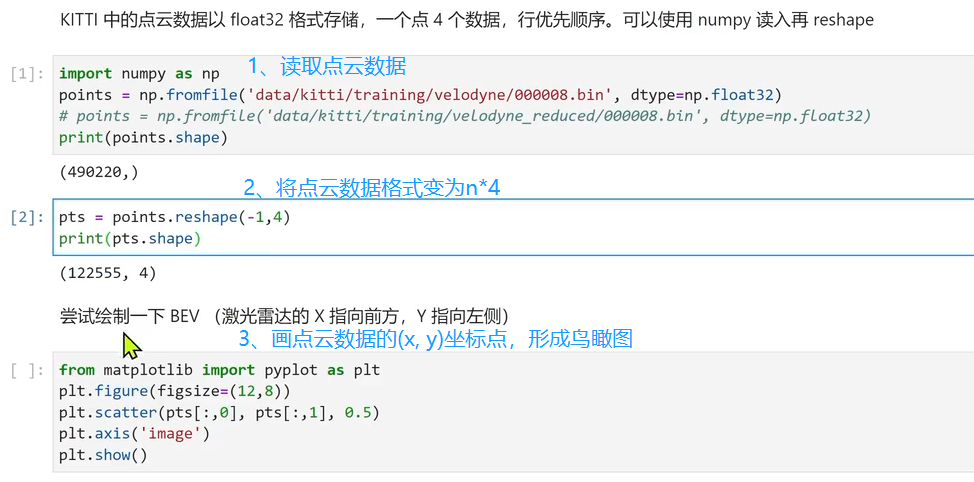
BEV鸟瞰图效果如下:
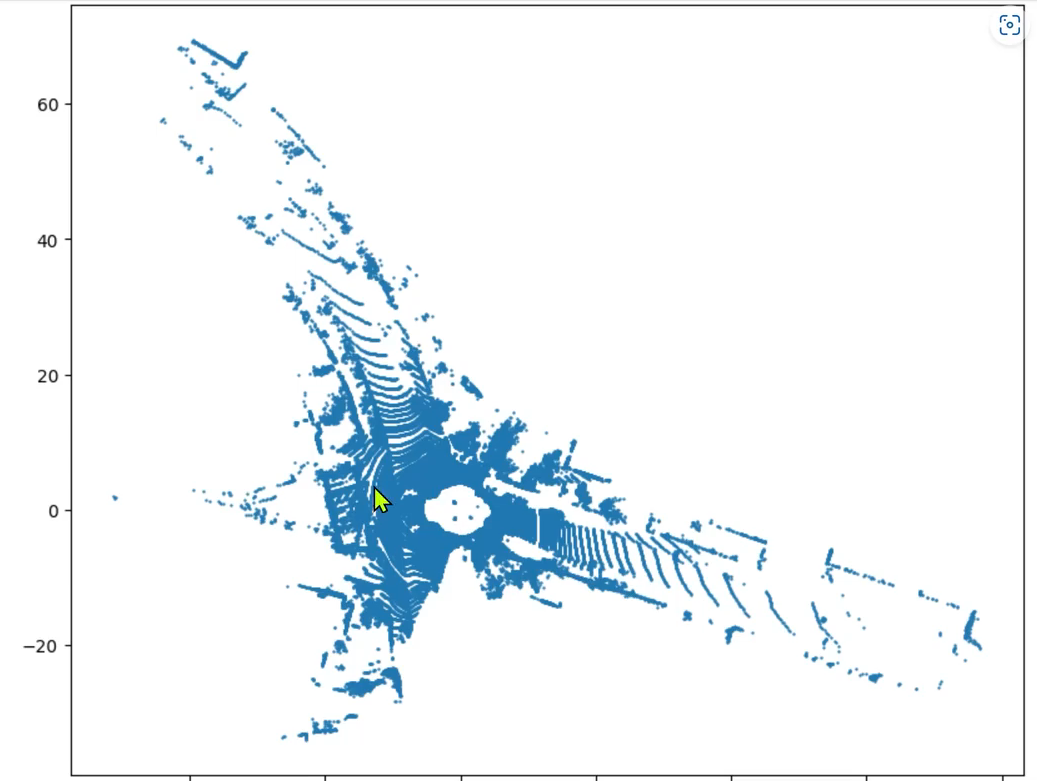
10、绘制BEV鸟瞰图
BEV图像示例效果:

核心代码:
'''
可视化BEV鸟瞰图
'''
def show_lidar_topview(pc_velo, objects, calib):
# 1-设置鸟瞰图范围
side_range = (-30, 30) # 左右距离
fwd_range = (0, 80) # 后前距离
x_points = pc_velo[:, 0]
y_points = pc_velo[:, 1]
z_points = pc_velo[:, 2]
# 2-获得区域内的点
f_filt = np.logical_and(x_points > fwd_range[0], x_points < fwd_range[1])
s_filt = np.logical_and(y_points > side_range[0], y_points < side_range[1])
filter = np.logical_and(f_filt, s_filt)
indices = np.argwhere(filter).flatten()
x_points = x_points[indices]
y_points = y_points[indices]
z_points = z_points[indices]
# 定义了鸟瞰图中每个像素代表的距离
res = 0.1
# 3-1将点云坐标系 转到 BEV坐标系
x_img = (-y_points / res).astype(np.int32)
y_img = (-x_points / res).astype(np.int32)
# 3-2调整坐标原点
x_img -= int(np.floor(side_range[0]) / res)
y_img += int(np.floor(fwd_range[1]) / res)
print(x_img.min(), x_img.max(), y_img.min(), y_img.max())
# 4-填充像素值, 将点云数据的高度信息(Z坐标)映射到像素值
height_range = (-3, 1.0)
pixel_value = np.clip(a=z_points, a_max=height_range[1], a_min=height_range[0])
def scale_to_255(a, min, max, dtype=np.uint8):
return ((a - min) / float(max - min) * 255).astype(dtype)
pixel_value = scale_to_255(pixel_value, height_range[0], height_range[1])
# 创建图像数组
x_max = 1 + int((side_range[1] - side_range[0]) / res)
y_max = 1 + int((fwd_range[1] - fwd_range[0]) / res)
im = np.zeros([y_max, x_max], dtype=np.uint8)
im[y_img, x_img] = pixel_value
im2 = Image.fromarray(im)
im2.save('save_output/BEV.png')
im2.show()
11、BEV鸟瞰图画2d框
在BEV视图中画框,可视化结果:
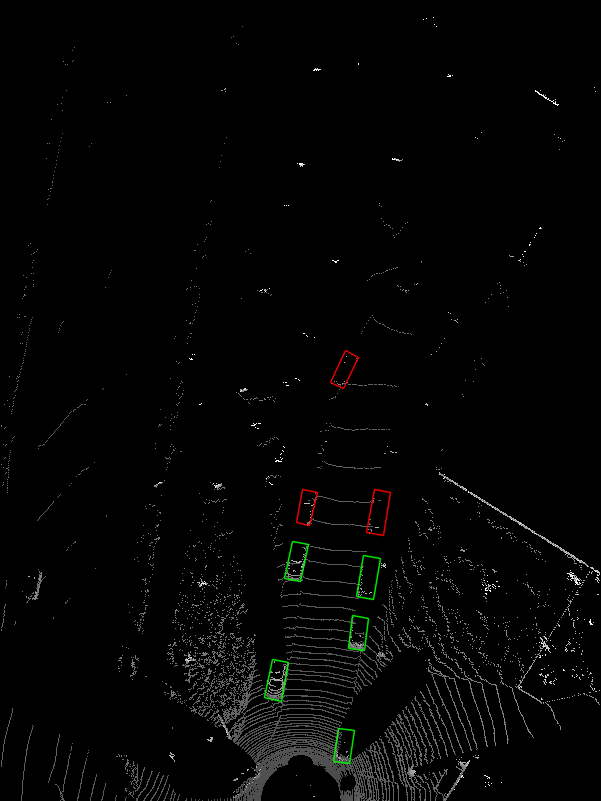
接口代码:
'''
将点云数据3D框投影到BEV
'''
def show_lidar_topview_with_boxes(img, objects, calib):
def bbox3d(obj):
box3d_pts_2d, box3d_pts_3d = utils.compute_box_3d(obj, calib.P) # 获取3D框-图像、3D框-相机坐标系
box3d_pts_3d_velo = calib.project_rect_to_velo(box3d_pts_3d) # 将相机坐标系的框 转到 激光雷达坐标系
return box3d_pts_3d_velo # 返回nx3的点
boxes3d = [bbox3d(obj) for obj in objects if obj.type == "Car"]
gt = np.array(boxes3d)
im2 = utils.draw_box3d_label_on_bev(img, gt, scores=None, thickness=1) # 获取激光雷达坐标系的3D点,选择x, y两维,画到BEV平面坐标系上
im2 = Image.fromarray(im2)
im2.save('save_output/BEV with boxes.png')
im2.show()
核心代码:
# 设置BEV鸟瞰图参数
side_range = (-30, 30) # 左右距离
fwd_range = (0, 80) # 后前距离
res = 0.1 # 分辨率0.05m
def compute_box_3d(obj, P):
'''
计算对象的3D边界框在图像平面上的投影
输入: obj代表一个物体标签信息, P代表相机的投影矩阵-内参。
输出: 返回两个值, corners_3d表示3D边界框在 相机坐标系 的8个角点的坐标-3D坐标。
corners_2d表示3D边界框在 图像上 的8个角点的坐标-2D坐标。
'''
# 计算一个绕Y轴旋转的旋转矩阵R,用于将3D坐标从世界坐标系转换到相机坐标系。obj.ry是对象的偏航角
R = roty(obj.ry)
# 物体实际的长、宽、高
l = obj.l;
w = obj.w;
h = obj.h;
# 存储了3D边界框的8个角点相对于对象中心的坐标。这些坐标定义了3D边界框的形状。
x_corners = [l/2,l/2,-l/2,-l/2,l/2,l/2,-l/2,-l/2];
y_corners = [0,0,0,0,-h,-h,-h,-h];
z_corners = [w/2,-w/2,-w/2,w/2,w/2,-w/2,-w/2,w/2];
# 1、将3D边界框的角点坐标从对象坐标系转换到相机坐标系。它使用了旋转矩阵R
corners_3d = np.dot(R, np.vstack([x_corners,y_corners,z_corners]))
# 3D边界框的坐标进行平移
corners_3d[0,:] = corners_3d[0,:] + obj.t[0];
corners_3d[1,:] = corners_3d[1,:] + obj.t[1];
corners_3d[2,:] = corners_3d[2,:] + obj.t[2];
# 2、检查对象是否在相机前方,因为只有在相机前方的对象才会被绘制。
# 如果对象的Z坐标(深度)小于0.1,就意味着对象在相机后方,那么corners_2d将被设置为None,函数将返回None。
if np.any(corners_3d[2,:]<0.1):
corners_2d = None
return corners_2d, np.transpose(corners_3d)
# 3、将相机坐标系下的3D边界框的角点,投影到图像平面上,得到它们在图像上的2D坐标。
corners_2d = project_to_image(np.transpose(corners_3d), P);
return corners_2d, np.transpose(corners_3d)
12、完整工程代码
工程目录:
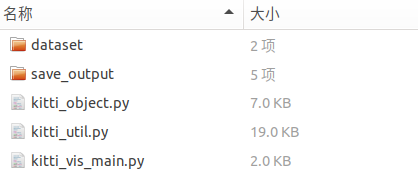
kitti_vis_main.py(主代码入口)
from __future__ import print_function
import os
import sys
import cv2
import os.path
from PIL import Image
BASE_DIR = os.path.dirname(os.path.abspath(__file__))
ROOT_DIR = os.path.dirname(BASE_DIR)
sys.path.append(BASE_DIR)
sys.path.append(os.path.join(ROOT_DIR, 'mayavi'))
from kitti_object import *
def visualization():
import mayavi.mlab as mlab
dataset = kitti_object(os.path.join(ROOT_DIR, 'Kitti_3D_Vis/dataset/object')) # linux 路径
data_idx = 10 # 选择第几张图像
# 1-加载标签数据
objects = dataset.get_label_objects(data_idx)
print("There are %d objects.", len(objects))
# 2-加载图像
img = dataset.get_image(data_idx)
img = cv2.cvtColor(img, cv2.COLOR_BGR2RGB)
img_height, img_width, img_channel = img.shape
# 3-加载点云数据
pc_velo = dataset.get_lidar(data_idx)[:,0:3] # (x, y, z)
# 4-加载标定参数
calib = dataset.get_calibration(data_idx)
# 5-可视化原始图像
print(' ------------ show raw image -------- ')
Image.fromarray(img).show()
# 6-在图像中画2D框
print(' ------------ show image with 2D bounding box -------- ')
show_image_with_boxes(img, objects, calib, False)
# 7-在图像中画3D框
print(' ------------ show image with 3D bounding box ------- ')
show_image_with_boxes(img, objects, calib, True)
# 8-将点云数据投影到图像
print(' ----------- LiDAR points projected to image plane -- ')
show_lidar_on_image(pc_velo, img, calib, img_width, img_height)
# 9-画BEV图
print('------------------ BEV of LiDAR points -----------------------------')
show_lidar_topview(pc_velo, objects, calib)
# 10-在BEV图中画2D框
print('--------------- BEV of LiDAR points with bobes ---------------------')
img1 = cv2.imread('save_output/BEV.png')
img = cv2.cvtColor(img1, cv2.COLOR_BGR2RGB)
show_lidar_topview_with_boxes(img1, objects, calib)
if __name__=='__main__':
visualization()
kitti_util.py
from __future__ import print_function
import numpy as np
import cv2
from PIL import Image
import os
# 设置BEV鸟瞰图参数
side_range = (-30, 30) # 左右距离
fwd_range = (0, 80) # 后前距离
res = 0.1 # 分辨率0.05m
def compute_box_3d(obj, P):
'''
计算对象的3D边界框在图像平面上的投影
输入: obj代表一个物体标签信息, P代表相机的投影矩阵-内参。
输出: 返回两个值, corners_3d表示3D边界框在 相机坐标系 的8个角点的坐标-3D坐标。
corners_2d表示3D边界框在 图像上 的8个角点的坐标-2D坐标。
'''
# 计算一个绕Y轴旋转的旋转矩阵R,用于将3D坐标从世界坐标系转换到相机坐标系。obj.ry是对象的偏航角
R = roty(obj.ry)
# 物体实际的长、宽、高
l = obj.l;
w = obj.w;
h = obj.h;
# 存储了3D边界框的8个角点相对于对象中心的坐标。这些坐标定义了3D边界框的形状。
x_corners = [l/2,l/2,-l/2,-l/2,l/2,l/2,-l/2,-l/2];
y_corners = [0,0,0,0,-h,-h,-h,-h];
z_corners = [w/2,-w/2,-w/2,w/2,w/2,-w/2,-w/2,w/2];
# 1、将3D边界框的角点坐标从对象坐标系转换到相机坐标系。它使用了旋转矩阵R
corners_3d = np.dot(R, np.vstack([x_corners,y_corners,z_corners]))
# 3D边界框的坐标进行平移
corners_3d[0,:] = corners_3d[0,:] + obj.t[0];
corners_3d[1,:] = corners_3d[1,:] + obj.t[1];
corners_3d[2,:] = corners_3d[2,:] + obj.t[2];
# 2、检查对象是否在相机前方,因为只有在相机前方的对象才会被绘制。
# 如果对象的Z坐标(深度)小于0.1,就意味着对象在相机后方,那么corners_2d将被设置为None,函数将返回None。
if np.any(corners_3d[2,:]<0.1):
corners_2d = None
return corners_2d, np.transpose(corners_3d)
# 3、将相机坐标系下的3D边界框的角点,投影到图像平面上,得到它们在图像上的2D坐标。
corners_2d = project_to_image(np.transpose(corners_3d), P);
return corners_2d, np.transpose(corners_3d)
def project_to_image(pts_3d, P):
'''
将相机坐标系下的3D边界框的角点, 投影到图像平面上, 得到它们在图像上的2D坐标
输入: pts_3d是一个nx3的矩阵, 包含了待投影的3D坐标点(每行一个点), P是相机的投影矩阵, 通常是一个3x4的矩阵。
输出: 返回一个nx2的矩阵, 包含了投影到图像平面上的2D坐标点。
P(3x4) dot pts_3d_extended(4xn) = projected_pts_2d(3xn) => normalize projected_pts_2d(2xn)
<=> pts_3d_extended(nx4) dot P'(4x3) = projected_pts_2d(nx3) => normalize projected_pts_2d(nx2)
'''
n = pts_3d.shape[0] # 获取3D点的数量
pts_3d_extend = np.hstack((pts_3d, np.ones((n,1)))) # 将每个3D点的坐标扩展为齐次坐标形式(4D),通过在每个点的末尾添加1,创建了一个nx4的矩阵。
pts_2d = np.dot(pts_3d_extend, np.transpose(P)) # 将扩展的3D坐标点矩阵与投影矩阵P相乘,得到一个nx3的矩阵,其中每一行包含了3D点在图像平面上的投影坐标。每个点的坐标表示为[x, y, z]。
pts_2d[:,0] /= pts_2d[:,2] # 将投影坐标中的x坐标除以z坐标,从而获得2D图像上的x坐标。
pts_2d[:,1] /= pts_2d[:,2] # 将投影坐标中的y坐标除以z坐标,从而获得2D图像上的y坐标。
return pts_2d[:,0:2] # 返回一个nx2的矩阵,其中包含了每个3D点在2D图像上的坐标。
def draw_projected_box3d(image, qs, color=(0,60,255), thickness=2):
'''
qs: 包含8个3D边界框角点坐标的数组, 形状为(8, 2)。图像坐标下的3D框, 8个顶点坐标。
'''
''' Draw 3d bounding box in image
qs: (8,2) array of vertices for the 3d box in following order:
1 -------- 0
/| /|
2 -------- 3 .
| | | |
. 5 -------- 4
|/ |/
6 -------- 7
'''
qs = qs.astype(np.int32) # 将输入的顶点坐标转换为整数类型,以便在图像上绘制。
# 这个循环迭代4次,每次处理一个边界框的一条边。
for k in range(0,4):
# Ref: http://docs.enthought.com/mayavi/mayavi/auto/mlab_helper_functions.html
# 定义了要绘制的边的起始点和结束点的索引。在这个循环中,它用于绘制边界框的前四条边。
i,j=k,(k+1)%4
cv2.line(image, (qs[i,0],qs[i,1]), (qs[j,0],qs[j,1]), color, thickness)
# 定义了要绘制的边的起始点和结束点的索引。在这个循环中,它用于绘制边界框的后四条边,与前四条边平行
i,j=k+4,(k+1)%4 + 4
cv2.line(image, (qs[i,0],qs[i,1]), (qs[j,0],qs[j,1]), color, thickness)
# 定义了要绘制的边的起始点和结束点的索引。在这个循环中,它用于绘制连接前四条边和后四条边的边界框的边。
i,j=k,k+4
cv2.line(image, (qs[i,0],qs[i,1]), (qs[j,0],qs[j,1]), color, thickness)
return image
def draw_box3d_label_on_bev(image, boxes3d, thickness=1, scores=None):
# if scores is not None and scores.shape[0] >0:
img = image.copy()
num = len(boxes3d)
for n in range(num):
b = boxes3d[n]
x0 = b[0, 0]
y0 = b[0, 1]
x1 = b[1, 0]
y1 = b[1, 1]
x2 = b[2, 0]
y2 = b[2, 1]
x3 = b[3, 0]
y3 = b[3, 1]
if (x0<30 and x1<30 and x2<30 and x3<30):
u0, v0 = lidar_to_top_coords(x0, y0)
u1, v1 = lidar_to_top_coords(x1, y1)
u2, v2 = lidar_to_top_coords(x2, y2)
u3, v3 = lidar_to_top_coords(x3, y3)
color = (0, 255, 0) # green
cv2.line(img, (u0, v0), (u1, v1), color, thickness, cv2.LINE_AA)
cv2.line(img, (u1, v1), (u2, v2), color, thickness, cv2.LINE_AA)
cv2.line(img, (u2, v2), (u3, v3), color, thickness, cv2.LINE_AA)
cv2.line(img, (u3, v3), (u0, v0), color, thickness, cv2.LINE_AA)
elif (x0<50 and x1<50 and x2<50 and x3<50):
color = (255, 0, 0) # red
u0, v0 = lidar_to_top_coords(x0, y0)
u1, v1 = lidar_to_top_coords(x1, y1)
u2, v2 = lidar_to_top_coords(x2, y2)
u3, v3 = lidar_to_top_coords(x3, y3)
cv2.line(img, (u0, v0), (u1, v1), color, thickness, cv2.LINE_AA)
cv2.line(img, (u1, v1), (u2, v2), color, thickness, cv2.LINE_AA)
cv2.line(img, (u2, v2), (u3, v3), color, thickness, cv2.LINE_AA)
cv2.line(img, (u3, v3), (u0, v0), color, thickness, cv2.LINE_AA)
else:
color = (0, 0, 255) # blue
u0, v0 = lidar_to_top_coords(x0, y0)
u1, v1 = lidar_to_top_coords(x1, y1)
u2, v2 = lidar_to_top_coords(x2, y2)
u3, v3 = lidar_to_top_coords(x3, y3)
cv2.line(img, (u0, v0), (u1, v1), color, thickness, cv2.LINE_AA)
cv2.line(img, (u1, v1), (u2, v2), color, thickness, cv2.LINE_AA)
cv2.line(img, (u2, v2), (u3, v3), color, thickness, cv2.LINE_AA)
cv2.line(img, (u3, v3), (u0, v0), color, thickness, cv2.LINE_AA)
return img
def draw_box3d_predict_on_bev(image, boxes3d, thickness=1, scores=None):
# if scores is not None and scores.shape[0] >0:
img = image.copy()
num = len(boxes3d)
for n in range(num):
b = boxes3d[n]
x0 = b[0, 0]
y0 = b[0, 1]
x1 = b[1, 0]
y1 = b[1, 1]
x2 = b[2, 0]
y2 = b[2, 1]
x3 = b[3, 0]
y3 = b[3, 1]
color = (255, 255, 255) # white
u0, v0 = lidar_to_top_coords(x0, y0)
u1, v1 = lidar_to_top_coords(x1, y1)
u2, v2 = lidar_to_top_coords(x2, y2)
u3, v3 = lidar_to_top_coords(x3, y3)
cv2.line(img, (u0, v0), (u1, v1), color, thickness, cv2.LINE_AA)
cv2.line(img, (u1, v1), (u2, v2), color, thickness, cv2.LINE_AA)
cv2.line(img, (u2, v2), (u3, v3), color, thickness, cv2.LINE_AA)
cv2.line(img, (u3, v3), (u0, v0), color, thickness, cv2.LINE_AA)
return img
def lidar_to_top_coords(x, y, z=None):
if 0:
return x, y
else:
# print("TOP_X_MAX-TOP_X_MIN:",TOP_X_MAX,TOP_X_MIN)
xx = (-y / res).astype(np.int32)
yy = (-x / res).astype(np.int32)
# 调整坐标原点
xx -= int(np.floor(side_range[0]) / res)
yy += int(np.floor(fwd_range[1]) / res)
return xx, yy
# 解析标签数据
class Object3d(object):
''' 3d object label '''
def __init__(self, label_file_line):
data = label_file_line.split(' ')
data[1:] = [float(x) for x in data[1:]]
# extract label, truncation, occlusion
self.type = data[0] # 'Car', 'Pedestrian', ...
self.truncation = data[1] # truncated pixel ratio [0..1]
self.occlusion = int(data[2]) # 0=visible, 1=partly occluded, 2=fully occluded, 3=unknown
self.alpha = data[3] # object observation angle [-pi..pi]
# extract 2d bounding box in 0-based coordinates
self.xmin = data[4] # left
self.ymin = data[5] # top
self.xmax = data[6] # right
self.ymax = data[7] # bottom
self.box2d = np.array([self.xmin,self.ymin,self.xmax,self.ymax])
# extract 3d bounding box information
self.h = data[8] # box height
self.w = data[9] # box width
self.l = data[10] # box length (in meters)
self.t = (data[11],data[12],data[13]) # location (x,y,z) in camera coord.
self.ry = data[14] # yaw angle (around Y-axis in camera coordinates) [-pi..pi]
def print_object(self):
print('Type, truncation, occlusion, alpha: %s, %d, %d, %f' % \
(self.type, self.truncation, self.occlusion, self.alpha))
print('2d bbox (x0,y0,x1,y1): %f, %f, %f, %f' % \
(self.xmin, self.ymin, self.xmax, self.ymax))
print('3d bbox h,w,l: %f, %f, %f' % \
(self.h, self.w, self.l))
print('3d bbox location, ry: (%f, %f, %f), %f' % \
(self.t[0],self.t[1],self.t[2],self.ry))
class Calibration(object):
''' Calibration matrices and utils
3d XYZ in
kitti_object.py
from __future__ import print_function
import os
import sys
import cv2
import numpy as np
from PIL import Image
import matplotlib.pyplot as plt
BASE_DIR = os.path.dirname(os.path.abspath(__file__))
ROOT_DIR = os.path.dirname(BASE_DIR)
sys.path.append(os.path.join(ROOT_DIR, 'mayavi'))
import kitti_util as utils
'''
在图像中画2D框、3D框
'''
def show_image_with_boxes(img, objects, calib, show3d=True):
img1 = np.copy(img) # for 2d bbox
img2 = np.copy(img) # for 3d bbox
for obj in objects:
if obj.type=='DontCare':continue
cv2.rectangle(img1, (int(obj.xmin),int(obj.ymin)), (int(obj.xmax),int(obj.ymax)), (0,255,0), 2) # 画2D框
box3d_pts_2d, box3d_pts_3d = utils.compute_box_3d(obj, calib.P) # 获取图像3D框(8*2)、相机坐标系3D框(8*3)
img2 = utils.draw_projected_box3d(img2, box3d_pts_2d) # 在图像上画3D框
if show3d:
Image.fromarray(img2).save('save_output/image_with_3Dboxes.png')
Image.fromarray(img2).show()
else:
Image.fromarray(img1).save('save_output/image_with_2Dboxes.png')
Image.fromarray(img1).show()
'''
可视化BEV鸟瞰图
'''
def show_lidar_topview(pc_velo, objects, calib):
# 1-设置鸟瞰图范围
side_range = (-30, 30) # 左右距离
fwd_range = (0, 80) # 后前距离
x_points = pc_velo[:, 0]
y_points = pc_velo[:, 1]
z_points = pc_velo[:, 2]
# 2-获得区域内的点
f_filt = np.logical_and(x_points > fwd_range[0], x_points < fwd_range[1])
s_filt = np.logical_and(y_points > side_range[0], y_points < side_range[1])
filter = np.logical_and(f_filt, s_filt)
indices = np.argwhere(filter).flatten()
x_points = x_points[indices]
y_points = y_points[indices]
z_points = z_points[indices]
# 定义了鸟瞰图中每个像素代表的距离
res = 0.1
# 3-1将点云坐标系 转到 BEV坐标系
x_img = (-y_points / res).astype(np.int32)
y_img = (-x_points / res).astype(np.int32)
# 3-2调整坐标原点
x_img -= int(np.floor(side_range[0]) / res)
y_img += int(np.floor(fwd_range[1]) / res)
print(x_img.min(), x_img.max(), y_img.min(), y_img.max())
# 4-填充像素值, 将点云数据的高度信息(Z坐标)映射到像素值
height_range = (-3, 1.0)
pixel_value = np.clip(a=z_points, a_max=height_range[1], a_min=height_range[0])
def scale_to_255(a, min, max, dtype=np.uint8):
return ((a - min) / float(max - min) * 255).astype(dtype)
pixel_value = scale_to_255(pixel_value, height_range[0], height_range[1])
# 创建图像数组
x_max = 1 + int((side_range[1] - side_range[0]) / res)
y_max = 1 + int((fwd_range[1] - fwd_range[0]) / res)
im = np.zeros([y_max, x_max], dtype=np.uint8)
im[y_img, x_img] = pixel_value
im2 = Image.fromarray(im)
im2.save('save_output/BEV.png')
im2.show()
'''
将点云数据3D框投影到BEV
'''
def show_lidar_topview_with_boxes(img, objects, calib):
def bbox3d(obj):
box3d_pts_2d, box3d_pts_3d = utils.compute_box_3d(obj, calib.P) # 获取3D框-图像、3D框-相机坐标系
box3d_pts_3d_velo = calib.project_rect_to_velo(box3d_pts_3d) # 将相机坐标系的框 转到 激光雷达坐标系
return box3d_pts_3d_velo # 返回nx3的点
boxes3d = [bbox3d(obj) for obj in objects if obj.type == "Car"]
gt = np.array(boxes3d)
im2 = utils.draw_box3d_label_on_bev(img, gt, scores=None, thickness=1) # 获取激光雷达坐标系的3D点,选择x, y两维,画到BEV平面坐标系上
im2 = Image.fromarray(im2)
im2.save('save_output/BEV with boxes.png')
im2.show()
'''
将点云数据投影到图像
'''
def show_lidar_on_image(pc_velo, img, calib, img_width, img_height):
''' Project LiDAR points to image '''
imgfov_pc_velo, pts_2d, fov_inds = get_lidar_in_image_fov(pc_velo,
calib, 0, 0, img_width, img_height, True)
imgfov_pts_2d = pts_2d[fov_inds,:]
imgfov_pc_rect = calib.project_velo_to_rect(imgfov_pc_velo)
import matplotlib.pyplot as plt
cmap = plt.cm.get_cmap('hsv', 256)
cmap = np.array([cmap(i) for i in range(256)])[:,:3]*255
for i in range(imgfov_pts_2d.shape[0]):
depth = imgfov_pc_rect[i,2]
color = cmap[int(640.0/depth),:]
cv2.circle(img, (int(np.round(imgfov_pts_2d[i,0])),
int(np.round(imgfov_pts_2d[i,1]))),
2, color=tuple(color), thickness=-1)
Image.fromarray(img).save('save_output/lidar_on_image.png')
Image.fromarray(img).show()
return img
'''
将点云数据投影到相机坐标系
'''
def get_lidar_in_image_fov(pc_velo, calib, xmin, ymin, xmax, ymax,
return_more=False, clip_distance=2.0):
''' Filter lidar points, keep those in image FOV '''
pts_2d = calib.project_velo_to_image(pc_velo)
fov_inds = (pts_2d[:,0]=xmin) & \
(pts_2d[:,1]=ymin)
fov_inds = fov_inds & (pc_velo[:,0]>clip_distance)
imgfov_pc_velo = pc_velo[fov_inds,:]
if return_more:
return imgfov_pc_velo, pts_2d, fov_inds
else:
return imgfov_pc_velo
'''
解析标签
'''
class kitti_object(object):
'''Load and parse object data into a usable format.'''
def __init__(self, root_dir, split='training'):
'''root_dir contains training and testing folders'''
self.root_dir = root_dir
self.split = split
self.split_dir = os.path.join(root_dir, split)
if split == 'training':
self.num_samples = 7481
elif split == 'testing':
self.num_samples = 7518
else:
print('Unknown split: %s' % (split))
exit(-1)
self.image_dir = os.path.join(self.split_dir, 'image_2')
self.calib_dir = os.path.join(self.split_dir, 'calib')
self.lidar_dir = os.path.join(self.split_dir, 'velodyne')
self.label_dir = os.path.join(self.split_dir, 'label_2')
def __len__(self):
return self.num_samples
def get_image(self, idx):
assert(idx
运行程序后kitti_vis_main.py后,回保存5张结果图片
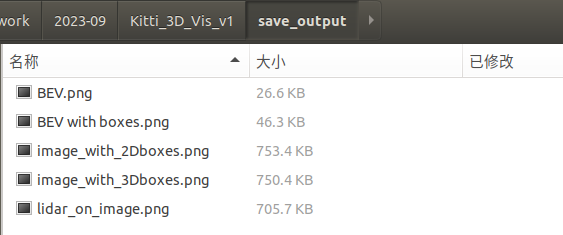

后面还会介绍Nuscenes、Waymo等3D数据集。
猜你喜欢
网友评论
- 搜索
- 最新文章
- 热门文章
